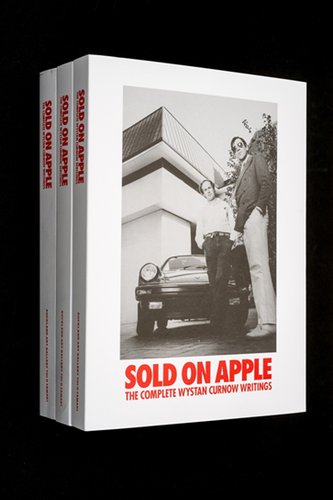John Hurrell – 23 January, 2016
It is to be expected of course that any critic's relationships with artists will on occasion be strained because the two creative roles have clashing political agendas. However there is the view that an obligatory adversarial component is intrinsically built into the task of being a critic, and that the ‘job description' is not about selectively picking only ‘A Team' artists to promote, but about attacking at times other (or even the same) artists as well.
Sold On Apple: The Complete Wystan Curnow Writings
Texts by Wystan Curnow on Billy Apple
Edited by Zara Stanhope
Design: Inhouse
244 pp, b/w photographs, softcover
Auckland Art Gallery Toi o Tamaki, 2015
This publication accompanies Christina Barton’s earlier launched Billy Apple®: A life in Parts as a companion publication for her curated Apple survey at Auckland Art Gallery Toi o Tamaki, The Artist Has to Live Like Everybody Else. It is very different from the other recent (much thicker and also overdue) Wystan Curnow anthology, The Critic’s Part: Art Writings 1971 - 2013 in that it focuses on one artist only and emphasises Curnow’s role not as critic but as collaborator, participant, (at times) road manager and strategist.
This distinction is not hard and fast, for Curnow does candidly ‘participate’ with artists like Apple and Bruce Barber in The Critic’s Part, but he does have an exceptionally close working friendship with Apple that makes Sold On Apple (like The Critic’s Part) essential reading for anybody interested in New Zealand art from the seventies on. While there are other superb writers on Apple around, like Tina Barton, Anthony Byrt or Tony Green, and while there are a few areas of Apple’s practice he has not examined at length (like The Immortalisation), the sheer quantity of his writing and his profound depth of knowledge on this artist makes him distinctive.
Curnow does not consider the two ‘hats’ of criticism and artistic collaboration to be opposed or contradictory, but easily worn together. Perhaps it can be argued that he is not facing up to the responsibilities of criticism? Can a true critic ever be friends with artists?
It is to be expected of course that any critic’s relationships with artists will on occasion be strained because the two creative roles have clashing political agendas. However there is the view that an obligatory adversarial component is intrinsically built into the task of being a critic (to offset the imbalance from so much art writing being overtly promotional), and that the ‘job description’ is not about selectively picking only ‘A Team’ artists to promote, but about attacking at times other (or even the same) artists as well, or at the very least, drawing out unsettling ambivalences or irritating inconsistencies.
Most writers who have researched Apple‘s extraordinary career will be familiar with Curnow’s lengthy articles (now online) for Art New Zealand and Auckland Art Gallery Quarterly on the two seventies tours, but there is also a vast amount of other important (but little known) material presented here.
The many surprises amongst the forty items of this wide-ranging anthology include: a recent overall update on his activities with Apple (‘Working with Apple’); a pink page work previously only seen in And 2; two rare Apple drawings (unsigned of course), studies for The Artist Has to Live Like Everybody Else, and Notes for 4 Knots; transcripts of interviews that Curnow and Apple did with Angela D’Audney (Kaleidoscope TV program), Sandra Peacocke (Cha Cha magazine), and Michael Woolf (Radio New Zealand Concert program); A Tales of Gold centrefold for Pavement magazine with spiralling texts that diminish according to the Golden Rectangle; ‘BLOND AMBITION: Barrie Bates to Billy Apple 1959-1963’, an unpublished 1997 text reworked in 2015 after Barton and Curnow have compared notes and discussed various topics such as Apple’s life as a student in London; one piece (‘Considerations’) that looks at the ‘white cube’ and Apple’s international context alongside the related practices of others; various short essays done for exhibitions in private offices of law firms (Minter Ellison Rudd Watts), shops (Parsons Bookshop) or galleries such as Artspace, Two Rooms, Lopdell House, Lett or Bath St.
This is a wonderful, deliciously packed book. The Critic’s Part is fascinating because of the range of Curnow’s interests, stylistic explorations and prescient observations that investigate writing per se, but this publication is quite different. It is better, I think. Its pieces are mostly shorter, and it has real focus and a lot of condensed art historical detail. Some of the other artists Curnow discusses in the larger tome may not excite you much (so reading those pieces would really be about being curious about Curnow’s writing/thinking tics or stylistic influences, not about persuasion), but as subject matter Apple (and pre-1962 Apple, Barrie Bates) is a different proposition. He is in a league of his own.
The densely informative, elegantly written articles within Sold On Apple (published in the order they appeared) work well alongside the unfolding elucidations of Barton‘s similarly sized book that is clearly based on a different (year by year) structure. While it is great that AAG has published them both rather than nothing at all, it is also fair to say that in any equivalent overseas institution an artist of Apple’s stature would have had a thick hardcover publication with coloured images documenting the survey‘s contents in itemised detail. Beside ‘conceptual’, Apple is sensual and sexy, and hopefully one day such a publication will appear to confirm that.
John Hurrell

 Advertising in this column
Advertising in this column Two Rooms presents a program of residencies and projects
Two Rooms presents a program of residencies and projects



This Discussion has 0 comments.
Comment
Participate
Register to Participate.
Sign in
Sign in to an existing account.